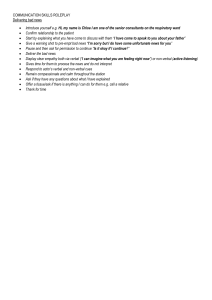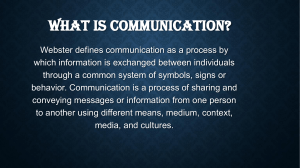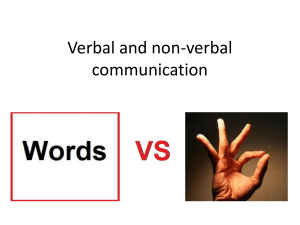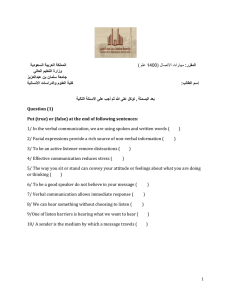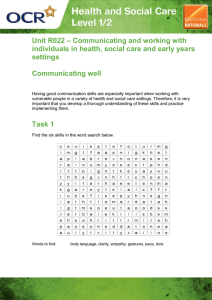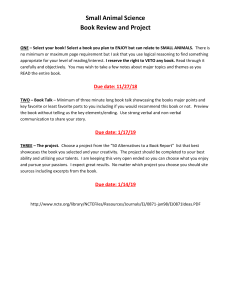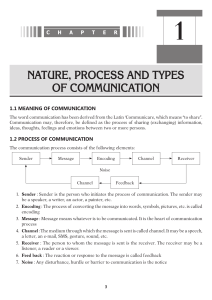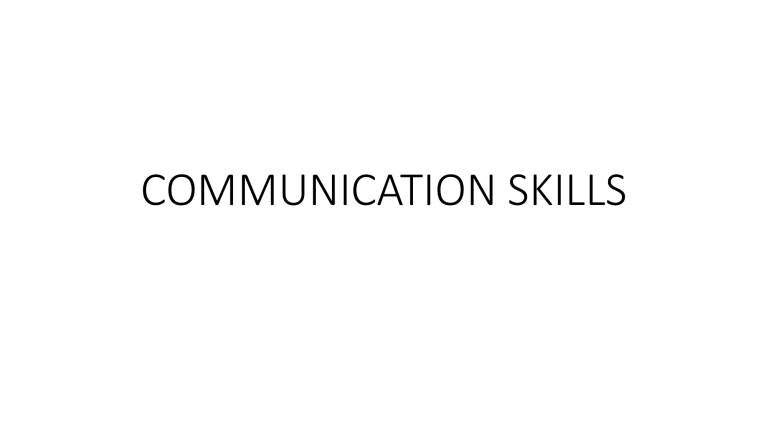
COMMUNICATION SKILLS TO BE DISCUSSED…… • COMMUNICATION • COMMUNICATION CYCLE • COMMUNICATION STYLES • INTRODUCTION TO VERBAL COMMUNICATION • INTRODUCTION TO NON-VERBAL COMMUNICATION • WRITTEN COMMUNICATION • PRESPECTIVES IN COMMUNICATION • FACTORS AFFECTING COMMUNICATION AT WORK PLACE • BASIC WRITING SKILLS COMMUNICATION • Information by signs and signals speaking, writing or using some other medium and means is called communication. • Learning objectives of Effective communication • 1. Sending, receiving and understanding the message or information. • 2. Development of Interpersonal Skills • 3. To express effectively & with maximum efficiency COMMUNICATION CYCLE • Communication Cycle is the process by which a message is sent by one individual and it passes through a chain of recipients. The timings and effectiveness of a communication cycle is based on how long it takes for feedback to be received by the initial sender • Sender: the person or entity originating the communication . • Message: the information that the sender wishes to convey . • Encoding: how the sender chooses to bring the message into a form appropriate for sending . • • • • Channel: the means by which the message is sent Receiver: the person or entity to whom the message is sent Decoding: how the receiver interprets and understands the message Feedback: the receiver's response to the message COMMUNICATION STYLES • There are four main categories or communication styles including verbal, non-verbal, written and visual. Verbal • Verbal communication is the use of language to transfer information through speaking or sign language. It is one of the most common types, often used during presentations, video conferences and phone calls, meetings and one-on-one conversations. Verbal communication is important because it is efficient. It can be helpful to support verbal communication with both non-verbal and written communication. Non-verbal • Nonverbal communication is the use of body language, gestures and facial expressions to convey information to others. It can be used both intentionally and unintentionally. • Non-verbal communication is helpful when trying to understand others’ thoughts and feelings. Visual- Visual communication is the act of using photographs, videos, art, drawings, sketches, charts and graphs to convey information. Visuals are often used as an aid during presentations to provide helpful context alongside written and/or verbal communication. Since people have different learning styles, visual communication might be more helpful for some to consume ideas and information.. Written • Written communication is the act of writing, typing or printing symbols like letters and numbers to convey information. It is helpful because it provides a record of information for reference. Writing is commonly used to share information through books, pamphlets, blogs, letters, memos and more. Emails and chats are a common form of written communication in the workplace. • Written communication has been proved to be a boon to regulate the daily operations of an organisation. This communication may include memos, letters, documents, and feedback results etc. The reliability proffered by written communication is indeed remarkable and phenomenal. However, as there are many advantages associated with this medium of communication, there are also multiple disadvantages associated with its being. In this connection, in order to equip a detailed insight, below mentioned are the pros and cons provided by the written communication. Advantages of Written Communication: • The major advantages of written communication are listed below: A Permanent Record: • A written communication helps to maintain a permanent record of the information exchanged or shared. Meticulous Presentation: • As a written document is a permanent record, people are very cautious to fulfil all the writing requisites to make the writing perceivable at the other end. Thus, every document curated covers all major information pointers necessary to be communicated. Easy Circulation: • A written document can easily be circulated in an organisation, unlike the oral communication medium. Thus, this attribute of written communication comes handy in equipping the masses with the necessary information. Suitable for Statistical Data: • Statistical charts and figures are difficult to be interpreted verbally, thus, circulating a document allow people to examine such intrinsic detail with ease. Promotes Goodwill: • When conducting business, a well-crafted written document speaks volumes about the competence of a particular organisation. Therefore, written communication helps to promote goodwill if performed wisely. Disadvantages of Written Communication The main disadvantages encountered are: Time Consuming: • In order to craft an impeccable piece of document, one has to invest an ample amount of time which is indeed difficult in constrained timelines. Non-flexible: • A written document cannot be altered once circulated. This makes written communication non-flexible as every written word is concrete and final No Scope for Clarification: • If the document is not curated keeping the less informed person’s mind-set in check, the details cannot be perceived by such people via the formulated written document. • Demands Writing Proficiency: • In order to deliver the message adequately across the other end, one should have competencies in the writing sector. Probability of Wrong Interpretation: • If there are complex words or difficult sentences included in the writing document, one may interpret a wrong/no meaning out of it. Thus, in order to use written communication, one should make use of easy language. 4. Introduction to Verbal and Non-Verbal Communication • Verbal and non-verbal communication go hand in hand in day to day interactions. Let us understand this through an activity. • Body language is an aspect of non -verbal communication where physical behavior is used (as opposed to or in addition to words) to convey information. It’s important that our body language synergizes with our words. • Body language includes: • Facial expressions • Posture • Gestures • touch • The use of space • Eye movement • It’s also known as “kinesics”. • The Dos and Don’ts of non- verbal messages and body language DOs • Make eye contact. ... • Have a firm handshake. ... • Check your facial expression. ... • Be natural with your gestures • Maintain a receptive posture. ... • Refrain from sending mismatched messages. ... • Watch for actions that can be taken for defensiveness. ... • Don't appear disengaged. Don’ts • Rubbing your hands together during an important meet up • Leaning back while meeting with a friend or close colleague. • Crossing your arms during an interesting conversation. • Not making eye contact. • Making too much eye contact. • Fidgeting. • Touching your face too often. Advantages of Verbal Communication Skill: It saves time: • The verbal form of communication gives you this facility to quickly send intended message thus saving you time. It saves you money: No requirement of paper or designing a flyer etc Feedback quickness: • The distinct advantage of verbal communication is in the fact that the receiver can ask and clarifies his doubt on the spot without any delay. The sender can get quick feedback as to whether his intended message is received in its intended form or not and can clarify the receiver, in the case of any doubt. • Most convenient method: Verbal communication is the most widely adopted means of communication globally. People prefer more of verbal communication due to the convenience factor. While communicating verbally, you are more likely to convey matter simply in plain understandable language which is widely preferred. • Ease of preparation: • Oral communication is the easiest way of communication as it does not require preparation of any material. • Disadvantages of Verbal Communication: Chances of distortion of meaning: • Due to the presence of various barriers in effective communication, it happens that the intended meaning of the message changes for the intended person which causes a lot of problems in the future. • Not convenient for long messages: • It is not at all convenient to convey long messages orally as it may happen that by the time message is completed, the receiver may forget the previously spoken important points leading to a chance of ineffective communication. • Irrelevant information: • While having an important discussion, a lot of irrelevant information can creep in during a conversation leading to a waste of time and gap in the relevant information. This leads to unnecessary time waste and sometimes omitting or forgetting to converse on what is really important. Therefore it is always necessary to keep your communication process clear of any unwanted discussion that may lead to wastage of your precious time and energy. • Create a misunderstanding: • Usually, when two individuals are having deep conversations, they can have some misunderstandings during the time. Sometimes subtle hints given or some words spoken with some intention get misinterpreted and a whole new different meaning comes out of it. Thus it becomes crucial to know that what you have has a crystal clear meaning with no indirect hints that could make a conversation difficult. Communication cost: • Sometimes verbal communication can be really expensive if you need to communicate in a language that you are not familiar with. You will need another person to play the part of translator for you. With advanced technology of hologram, translator may not be required but surely big cost is involved. Conclusion: • Verbal communication is the most efficient way of communicating between two personnel or groups. The verbal communication provides you the mean to handle the everyday task with ease and helps in getting a quick result as the feedback is quick and the message conveyed in verbal format is quick and direct to the point. Verbal communication forms a great chunk of our daily communication. Advantages of non-verbal communication: Complementary: Non-verbal cues complement a verbal message by adding to its meaning. Easy presentation: Information can be easily presented in non-verbal communication through using visual, audio-visual and silent means of non-verbal communication. Substituting: Non-verbal messages may substitute for the verbal message especially if it is blocked by noise, interruption, long-distance, language barrier etc. for example; gestures-finger to lips to indicate need for quiet, facial expressions- a nod instead of a yes. Reducing wastage of time: The message of non-verbal communication reached the receiver very fast. For this reason, • Non-verbal cues of communication like sign and symbol can also communicate some messages very quickly than written or oral messages. • Disadvantages or limitations of non-verbal communication: • Despite of advantages of non-verbal communication, it is not free from its limitations or disadvantages which are: • Vague and imprecise: Non-verbal communication is quite vague and imprecise. Since in this communication, there is no use of words or language which expresses clear meaning to the receiver. No dictionary can accurately classify them. Their meaning varies not only by culture and context but by the degree of intention. • Continuous: It is possible to stop talking in verbal communication, but it is generally not possible to stop non-verbal cues. • Multi-channel: while watching someone’s eyes, you may miss something significant in a hand gesture. Everything is happening at once and therefore it may be confusing to keep up with everything. • Culture bound: Non-verbal communication is learned in childhood, passed on to you by your parents and others with whom you associate. A few other gestures seem to be universal. Evidence suggests that humans of all cultures smile when happy and frown when unhappy. However, most non-verbal symbols seem to be even further disconnected from any “essential meaning” than verbal symbols. Gestures seen as positive in one culture (Like the thumbs-up gesture in the USA) may be seen as obscene in another culture. • Long conversations are not possible: In non-verbal communication, long conversation and necessary explanations are not possible. Perspectives in Communication • perspective focuses on the way in which our shared meanings and practices are constituted through language and symbol, the construction of messages, and their dissemination through media, organizations, and society. • We all come to each communication exchange with our own ‘filter’ through which we see the world, the person we are communicating with, and the situation or topic we are communicating about. These filters mean that we don’t always start with the same perspective as the person we are communicating with shall differ each time. • Visual perception • Visual perception is the ability to see and interpret (analyse and give meaning to) the visual informat • Language -The different perspectives we experience can be with language as well. • Past Experiences • Prejudices • Prejudices occur when we take an isolated experience with one ‘type’ of person and then act as if all encounters in the future with people of the same ‘type’ or with the same characteristics will result in the same experience ion that surrounds us. • Feelings • There are actually two ways in which your feelings can influence your communication with another person. The first simply refers to the way that you feel on a given day; if you feel well, you’ll communicate in one way and if you feel ill you’ll communicate in another way • The second aspect related to feelings refers to how you feel about a specific person • Environment • The last area of influence on communication is your environment. All of us communicate differently in different environments.. Do you speak to our teachers the same way that you do to your friends? Do you talk to strangers with more or less formality than people you know well? Factors affecting Communication at Work place • 8 Factors Influencing the workplace Communication are; • Cultural Diversity. • When people from different cultural backgrounds communicate the chance of misunderstanding and wrong interpretation of the message is higher. • Misunderstanding of Message. • Emotional Difference. • Emotions and feelings of the parties involved in communication significantly affect the meaning of communication. For example, physicians are usually less emotional to the patient than those of the relatives of the patients. • Past Experiences. Educational and Intellectual Difference. • The difference in the informal educational and intellectual level of the sender and receiver also influences the meaning communication • If they have similar educational qualifications, communication will be effective because they are likely to hold similar perceptions, understanding ,feeling, thinking ,view,etc Group Affiliations. • Positional Differences among the Personnel. • If the sender and receiver hold different positions in the hierarchy, communication between them may fail. • For example, superiors usually pay less attention to any message from their subordinates. Also, subordinates try to avoid any instruction from the superiors to avoid the workload and responsibilities. • Functional Relationship between Sender and Receiver. The functional relationship between the sender and receiver significantly affects the meaning of communication in business. If the sender and receiver belong to different functional departments or areas, the receiver may not understand the sender’s message. Basic Writing Skills • Writing is a form of communication that allows students to put their feelings and ideas on paper, to organize their knowledge and beliefs into convincing arguments, and to convey meaning through wellconstructed text. In its most advanced form, written expression can be as vivid as a work of art. You must have read novels and story books in which the writer writes a scene in such a way that reader can visualize that clearly. • Kinds of sentences • A set of words that is complete in itself, typically containing a subject and predicate, conveying a statement, question, exclamation, or command, and consisting of a main clause and sometimes one or more subordinate clauses. • The above figure represents 4 types of sentences • The following link will further help to build up the concept) • (https://www.youtube.com/watch?v=IuDSRs_lZBk) Activity 2 • Reinforcement: Real World Application of Four Sentence Types • For reinforcement, students will use their new knowledge and skills of sentence types by using four different highlighters and finding the sentence types in one of their writing compositions. The students will choose one of their narratives in their writing notebook. They must choose a highlighter colour to represent each type of sentence. Then, they highlight sentences in their composition, color-coding them by type. Once they are have completed ,the teacher will see if they were able to identify the different types in their own writing. • Activity • Four Types of Sentences Exit Slip • Pass out the Exit Slip featured below and students use a color-coded system to write their punctuation and sentence-type names. • Example: • a) Declarative – orange b)Imperative – yellow c)Interrogative – blue d)Exclamatory – red • Activity 2 • Reinforcement: Real World Application of Four Sentence Types • For reinforcement, students will use their new knowledge and skills of sentence types by using four different highlighters and finding the sentence types in one of their writing compositions. The students will choose one of their narratives in their writing notebook. They must choose a highlighter colour to represent each type of sentence. Then, they highlight sentences in their composition, color-coding them by type. Once they are have completed ,the teacher will see if they were able to identify the different types in their own writing. • Activity • Four Types of Sentences Exit Slip • Pass out the Exit Slip featured below and students use a color-coded system to write their punctuation and sentence-type names. • Example: • a) Declarative – orange b)Imperative – yellow c)Interrogative – blue d)Exclamatory – red • Types-of-Sentences-Decoding-Sheet • To further augment the concept, worksheets can be done in the class. One of the examples is listed below Name: ________________________ Date: ______________ There are four kinds of sentences in the English language. • 1. Imperative- gives a command (.) • 2. Declarative- makes a statement (.) • 3. Interrogative- asks a question (?) • 4. Exclamatory- expresses strong feeling (!) • Activity- Self Introduction. • Step 1 – Teacher tells few students to introduce themselves to the class in whichever way they know • Step 2-Students identify the mistake or areas that can be improved. • Step 3- Teacher gives them a structure and sequence of self-introduction • Example • ● Good morning madam ,my name is • ● I am ___________ years old. • ● I live in ____________ • ● I am a student at _________________ • ● There are ______people in my family. They are ________________ • ● My favourite subject is ___________ • ● My hobbies are ____________ • ● I would like to be a/an _________ • Activity – Construct a paragraph using the set of pictures given • Step 1- Teachers randomly takes print out of some pictures and distribute among students who are divided in groups of 3 to 4 each. • Step 2- Students in groups discuss and weave a story out of those pictures and write in down. • Step 3-Students narrate that story in front of class using verbal and non-verbal cues • Activity 7 • The following activity is a way to make opinion or discursive essay writing lessons more interesting and learner-centred. The activity focuses on mistakes made at paragraph level in a text. Description • Students will be instructed to write paragraphs on some topics chosen by teacher eg-any of the current affairs, social issues etc. • These samples will be studied carefully followed by healthy discussion on mistakes done . • Next, a handout will be designed in which there is a copy of the paragraph with a table including two columns, comments and examples. Leave the "examples" column blank. Put your comments for the chosen paragraphs in the comments column. For example, 'Wrong word - register' or 'use a conjunction here' or 'spelling' or 'poor topic sentence'… • In class give out the handouts and ask students to work in pairs to find examples to support the comments made by the teacher. • This activity aims to help students to recognise their own problems with paragraph construction and to identify errors, which improves their own re-drafting skills.
